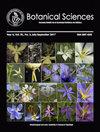景观异质性驱动退化影响下新热带雨林保护区棕榈群落的空间分布
IF 0.7
4区 生物学
Q3 PLANT SCIENCES
引用次数: 0
摘要
背景:本研究首次在景观尺度上评价了美国热带雨林北界分布的环境异质性与棕榈群落之间的关系。问题:景观层面的异质性(地形、地形、密度、多样性和树木生物量)如何塑造受退化影响的保护区内的棕榈群落?研究地点和日期:该研究于2020年在墨西哥韦拉克鲁斯的Los Tuxtlas热带生物学站进行。方法:以土壤和地貌为基础,对景观单元进行划分,刻画生物物理马赛克。我们建立了等级-丰度曲线来比较棕榈丰富度及其在LUs中的丰度。采用置换多元方差分析(Permutational multivariate analysis of variance, PERMANOVA)和非度量多维尺度(nonmetric multidimensional scaling, NMDS)来检测不同LUs棕榈群落的变化。结果:通过划分LUs,整合非生物和生物成分,使我们能够评估环境异质性对棕榈群落的多因素影响。受土壤粗粒破碎块、高程、坡度和年降水量的影响,各样地棕榈树的密度和组成变化显著。树木丰富度和密度对棕榈群落有显著影响,只有在与土壤地形变量结合分析时才有显著影响。结论:在景观尺度上,具有高度的土壤和地形异质性,影响着棕榈物种的分布。环境异质性方法允许捕获新的非生物变异来解释棕榈物种的分布模式及其在高度多样化的热带群落中的共存。本文章由计算机程序翻译,如有差异,请以英文原文为准。
Landscape heterogeneity drives spatial distribution of palm community in a Neotropical rainforest reserve affected by defaunation
Background: Our study presents the first assessment of the relationships between environmental heterogeneity and the palm community at the landscape scale at the northern boundary of tropical rainforest distribution in America.
Question: How does landscape-level heterogeneity (edaphic, topographic as well as the density, diversity, and tree biomass) shapes the palm community in a protected reserve affected by defaunation?
Study site and date: The study was carried out in Los Tuxtlas Tropical Biology Station, Veracruz, Mexico (2020).
Methods: We delineated landscape units (LUs) based on soil and geomorphology to characterize the biophysical mosaic. We built rank-abundance curves to compare the palm richness and their abundance among LUs. Permutational multivariate analysis of variance (PERMANOVA) and nonmetric multidimensional scaling (NMDS) were applied to detect shifts in the palm community across LUs.
Results: Integrating abiotic and biotic components by delimiting LUs allowed us to evaluate the multifactorial effect of environmental heterogeneity on the palm community. The density and composition of the palms changed significantly among the LUs, influenced by soil coarse fragments, elevation, slope inclination, and annual precipitation. Tree richness and density had a significant effect on the palm community only when analyzed in combination with the soil-topography variables.
Conclusions: The results reveal that there is high edaphic and topographic heterogeneity that influences palm species distribution at the landscape scale. The environmental heterogeneity approach allows capturing novel abiotic variation to explain the distribution patterns of palm species and their coexistence in highly diverse tropical communities.
求助全文
通过发布文献求助,成功后即可免费获取论文全文。
去求助
来源期刊

Botanical Sciences
Agricultural and Biological Sciences-Plant Science
CiteScore
1.90
自引率
21.40%
发文量
71
审稿时长
16 weeks
期刊介绍:
Botanical Sciences welcomes contributions that present original, previously unpublished results in Botany, including disciplines such as ecology and evolution, structure and function, systematics and taxonomy, in addition to other areas related to the study of plants. Research reviews are also accepted if they summarize recent advances in a subject, discipline, area, or developmental trend of botany; these should include an analytical, critical, and interpretative approach to a specific topic. Acceptance for reviews will be evaluated first by the Review Editor. Opinion Notes and Book Reviews are also published as long as a relevant contribution in the study of Botany is explained and supported.
 求助内容:
求助内容: 应助结果提醒方式:
应助结果提醒方式:


